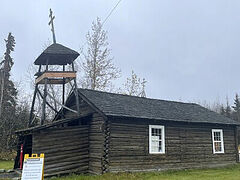Pskov, Pskov Province, Russia, February 14, 2024
 The restoration work on a revered 14th-century icon of Christ the Savior was recently completed, after which it was returned to its monastery home in the Pskov Province of Russia.
The restoration work on a revered 14th-century icon of Christ the Savior was recently completed, after which it was returned to its monastery home in the Pskov Province of Russia.
The wonderworking Eleazarov Icon of Christ the Savior was restored by the staff of the federal Pskov Museum-Preserve and returned to the Christ the Savior-Eleazar Monastery outside of Pskov, reports TASS.
The icon is one of the few remaining ancient monuments of Pskov iconography.
In 2010, responding to an appeal from the Pskov Diocese, the Russian Ministry of Culture had the icon transferred to the Eleazar Monastery, where it remains under museum supervision. A special kiot was prepared with vandal-proof glass and equipment for preserving the necessary temperature and humidity.
However, according to Svetlana Melnikova, General Director of the Pskov Museum-Preserve, during the last inspection of the icon, a slight elevation was detected. The Museum then took preventative and restorative measures, after which the icon was returned to the monastery.
 The monastery in the late 19th century. Photo: Wikipedia
The monastery in the late 19th century. Photo: Wikipedia
***
The wonderworking Christ the Savior-Eleazar Icon was revealed in a deserted place in the village of Sloboda in 1352, after which the Visokopustyn monastery was built on the site.
The icon saved Pskov several times throughout the centuries, including in the 14th century, when it was carried in procession around the city, saving the people from a deadly pestilence. In memory of this miracle, a procession was established on the feast of Pentecost, which continued until the years of godless atheism.
Due to the Church reforms of the 18th century, the monastery was closed in 1766 and the icon was transferred to another monastery, which is now known as the Christ the Savior-Eleazar Monastery in honor of the icon.
Dozens of people (museum staff, historians, art historians, restorers) risked their lives (and sometimes lost them) in order to save the icon during the persecutions and wars of the 20th century.
On August 19, 2010, the icon was returned to the monastery placed in the Cathedral of the Three Holy Hierarchs.
Follow OrthoChristian on Twitter, Vkontakte, Telegram, WhatsApp, MeWe, and Gab!



